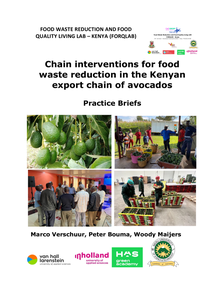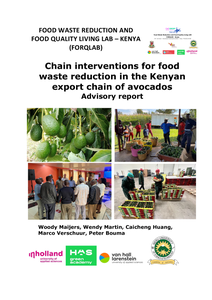Household food waste has a significant impact on the environment and to diminish this, understanding the effectiveness of different types of interventions, alone and in combination, is key. To better understand what makes waste-reduction interventions effective, we need to disentangle different intervention components. This study aims to contribute to existing knowledge by using the Motivation, Opportunity and Ability framework in guiding effective intervention development. In a two-by-two between subjects field study (N = 314), the effectiveness of an intervention containing a motivational, opportunity and ability component, is compared to an intervention containing only a motivational component and an intervention with a combined opportunity & ability component. Results indicate that only an intervention combining all MOA components (measuring cup with descriptive social norm) effectively reduces household grain waste (pasta, rice, couscous). This demonstrates the usefulness of the MOA framework in directing intervention development.
MULTIFILE
It is of utmost importance to collect organic waste from households as a separate waste stream. If collected separately, it could be used optimally to produce compost and biogas, it would not pollute fractions of materials that can be recovered from residual waste streams and it would not deteriorate the quality of some materials in residual waste (e.g. paper). In rural areas with separate organic waste collection systems, large quantities of organic waste are recovered. However, in the larger cities, only a small fraction of organic waste is recovered. In general, citizens dot not have space to store organic waste without nuisances of smell and/or flies. As this has been the cause of low organic waste collection rates, collection schemes have been cut, which created a further negative impact. Hence, additional efforts are required. There are some options to improve the organic waste recovery within the current system. Collection schemes might be improved, waste containers might be adapted to better suit the needs, and additional underground organic waste containers might be installed in residential neighbourhoods. There are persistent stories that separate organic waste collection makes no sense as the collectors just mix all municipal solid waste after collection, and incinerate it. Such stories might be fuelled by the practice that batches of contaminated organic waste are indeed incinerated. Trust in the system is important. Food waste is often regarded as unrein. Users might hate to store food waste in their kitchen that could attract insects, or the household pets. Hence, there is a challenge for socio-psychological research. This might also be supported by technology, e.g. organic waste storage devices and measures to improve waste separation in apartment buildings, such as separate chutes for waste fractions. Several cities have experimented with systems that collect organic wastes by the sewage system. By using a grinder, kitchen waste can be flushed into the sewage system, which in general produces biogas by the fermentation of sewage sludge. This is only a good option if the sewage is separated from the city drainage system, otherwise it might create water pollution. Another option might be to use grinders, that store the organic waste in a tank. This tank could be emptied regularly by a collection truck. Clearly, the preferred option depends on local conditions and culture. Besides, the density of the area, the type of sewage system and its biogas production, and the facilities that are already in place for organic waste collection are important parameters. In the paper, we will discuss the costs and benefits of future organic waste options and by discussing The Hague as an example.
DOCUMENT

From the article: "ABSTRACT: The research group Supply Chain Redesign in the Built Environment of HU University of Applied Sciences is working on research that combines principles of the circular economy with open source architectural design & urban planning. The aim is finding new ways to re-use demolition waste and recycled materials in small scale urban area developments. And to “democratize” traditional processes in the built environment. Different recent studies have shown the potential benefits, such as a reduction of emissions. In “Hof van Cartesius”, a practical case-study in Utrecht, the ambitions and implications of this approach are being questioned, investigated and tested."
DOCUMENT

From a circular standpoint it is interesting to reuse as much as possible construction and demolition waste (CDW) into new building projects. In most cases CDW will not be directly reusable and will need to be processed and stored first. In order to turn this into a successful business case CDW will need to be reused on a large scale. In this paper we present the concept of a centralized and coordinated location in the City of Utrecht where construction and demolition waste is collected, sorted, worked, stored for reuse, or shipped elsewhere for further processing in renewed materials. This has expected advantages for the amount of material reuse, financial advantages for firms and clients, generating employability in the logistics and processing of materials, optimizing the transport and distribution of materials through the city, and thus the reduction of emissions and congestion. In the paper we explore the local facility of a Circular Hub, and the potential effects on circular reuse, and other effects within the City of Utrecht.
DOCUMENT

PurposeFood waste is one of the most challenging issues humanity is currently facing. Therefore, there has been a growing interest in the prevention of food waste because of world hunger, environmental impacts, resource scarcity and economic costs. The purpose of the study is to investigate the factors that influence food waste and the role of technology in tackling food waste in India and the Netherlands.Design/methodology/approachIn order to explore differences in food loss and waste further this study will examine a number of practices on both the production and the consumer side, in a developing country and a developed country with different culture/economic backgrounds: India and the Netherlands. The factors that influence food waste were examined with a preliminary qualitative study, which consists of semi-structured interviews, and quantitative research that comprises a survey. Semi-structured interviews were conducted in both India and the Netherlands, which consists of five interviews. The survey data was collected from 78 individuals from India and 115 individuals from the Netherlands.FindingsOne of the main findings of the research is food waste is divided into waste within agricultural production (i.e. food loss) and final household consumption (i.e. food waste). Different factors influence food loss in different stages in the supply chain. Some of these factors include wastage during processing, storage, transportation and at the market-place. New technologies can utilize food loss for new purposes, so food loss is reduced to the minimum. Food waste is mainly influenced by food passing expiry date, food that is left too long in the fridge and consumers buying too much food. In final household consumption, technologies such as digital platforms enable individuals or organizations to share and donate their food, thereby creating awareness on food waste prevention and the environmental and ethical benefits.Originality/valueThe authors examine to what extent and in which ways supporting consumers to minimize food waste can be achieved via three stages: (1) understanding and evaluating food loss and waste, (2) identifying the factors that influence food loss and waste, (3) understanding consumer behaviors to encourage food waste reduction and (4) identifying the technological impact that would reduce food waste. As such, this paper contributes to ongoing debates about food waste by looking at the role of context and culture and by exploring differences between developed and developing countries. Also, the authors advance the debate by exploring both the role of advanced technology such as blockchain and drones in both preventing loss and waste as well as non-technological mechanisms.
DOCUMENT
This booklet presents the practice briefs (popular papers) of master and bachelor theses and business assignments of students at three Dutch Universities of Applied Sciences: Van Hall Larenstein (VHL), InHolland and HAS Green Academy, and Meru University of Science and Technology in Kenya. All theses and business assignments were commissioned through the researchproject entitled “Food Waste Reduction and Food Quality Living Lab (FORQLAB)” in Kenya.
DOCUMENT

This publication the avocado advisory report which is based on popular papers (practice briefs) of master and bachelor theses and business assignments of students at three Dutch Universities of Applied Sciences: Van Hall Larenstein (VHL), InHolland and HAS Green Academy, and Meru University of Science and Technology in Kenya. All 23 theses and business assignments were commissioned through the research project entitled “Food Waste Reduction and Food Quality LivingLab (FORQLAB)” in Kenya.
DOCUMENT

This study proposes a systematic value chain approach to helping businesses identify and eliminate inefficiencies. The authors have developed a robust framework, which food-sector entrepreneurs can use to increase profitability of an existing business or to create new profitable opportunities. The value chain approach provides win-win opportunities for players within the value chain. To test the robustness of the framework, the authors use food waste as an example of a critical inefficiency and apply it to two different food sector business cases, each operating in diverse conditions. Because the suggested framework addresses the core elements and parameters for the existence and competitiveness of a business, the model can be adapted to other sectors.
DOCUMENT

This chapter proposes sustainable supply chains in agrifoods, achieved through logistical strategies to minimize food waste and losses. Proposals will recover organic and inorganic waste and reincorporate it into the supply chain or add it to new chains through new products generated from food waste. A literature review is presented regarding the causes of food losses and waste within the supply chain and the strategic opportunities in the logistical process to reduce such losses. The creation of models that include the three dimensions of sustainability in food logistics is required in order to achieve a reduction in waste and food losses in transport, as well as to minimize costs and environmental impacts. If a correct sustainable logistics is carried out, it would favor the reincorporation of waste into new supply chains.
DOCUMENT
Food Loss and Waste (FLW) leads to societal and economic burden and also has substantial environmental impact The United Nations formulated food waste reduction targets within SDG 12.3 with the aim to halve global food waste by 2030. In Europe, food waste is estimated at approximately 88 million tons per year, which Is responsible for a significant environmental impact of the food supply. The Netherlands wants to be the first country in Europe to reach the 50% food waste reduction goal. The lack of consistent tools for measuring and monitoring food loss and waste exacerbate the food waste problem. The goal of our research is to assess existing tools and models for food waste monitoring and reporting in the food production to consumption chain, in order to understand the impact monitoring has on decision making. A consistent suite of measurement and monitoring tools for different actors in the food supply system will enable the business owners and policy makers gain a better understanding of their waste streams and take actions to prevent and minimize food waste. In this paper we focus on monitoring tools for food waste aiming to reduce FLW by Small and Medium-sized Enterprises (SMEs). We investigate which features of a monitoring tool wouldfacilitate SMEs to start measuring FLW and to what extent these are covered by current tools. In our analysis we compare 15 tools and identify 108 different features. Besides an overview of these FLW monitoringsystems, our paper addresses important methodological problems in monitoring and delineating food waste, which aims contribute to new standardized methodologies for FW monitoring. In the end, this project should lead to a food production and supply system that monitors its own loss and drastically reduces its waste streams.
LINK